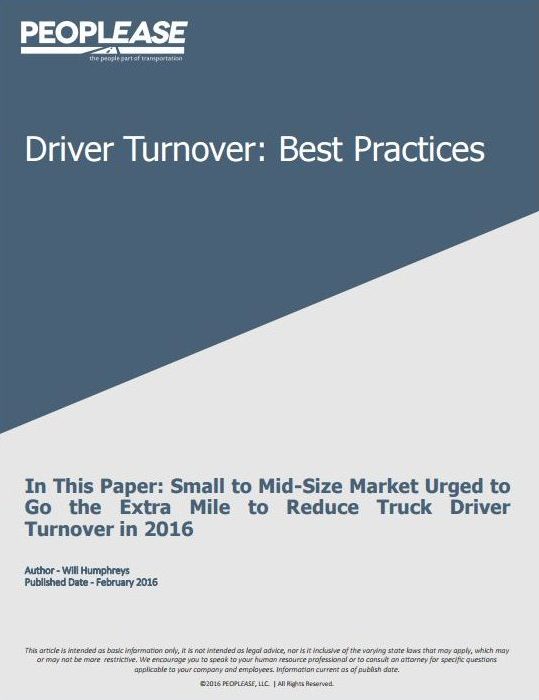Driver Turnover: Best Practices
Click here or on the image below to read the full white paper entitled “Driver Turnover: Best Practices”

Best Practices to Reduce Truck Driver Turnover
In This Paper: Small to Mid-Size Market Urged to Go the Extra Mile to Reduce Truck Driver Turnover in 2016
Whenever the trucking specialists at PEOPLEASE are discussing business pain points with a client, the majority of the
time our clients claim driver turnover as one of their most troubling. Fact is, truck driver turnover has a multitude of
origins, and sometimes a carefully crafted and personalized approach to addressing turnover needs be utilized so a
trucking company can overcome the challenge of negative driver attrition. The following are a few important steps
that would help bolster any truck driver turnover reduction initiative.
1. Understand That Trucking Is Special
While evaluating their turnover metrics, some trucking companies tend to compare against metrics that aren’t
trucking industry specific. Focusing on transportation industry specific metrics is critical. For example, consider this
helpful factoid reported by the American Trucking Association: “…the 11th consecutive quarter the turnover rate has
been above 90 percent at large trucking companies.” In other words, understanding how trucking industry leaders
are performing can set an accurate benchmark while beginning to evaluate turnover for your small to mid-size
trucking company.
2. Establish What Metrics Are Important to Your Business
We recommend that our clients carefully select and evaluate relevant turnover metrics. Quarterly, annually, etc. are
typical timeframes for evaluation, however, specialty haulers might have different ebbs and flows of hiring. Also,
many of PEOPLEASE’s clients have seasonal contracts, so turnover rates might spike based upon their hauling
specialty or regional concerns. For PEOPLEASE clients, customized turnover metrics can be populated rather easily.
Moreover, the PEOPLEASE trucking experts can populate, identify, and broadcast regional and national trends based
upon the collective turnover metrics generated from our vast national client base.
Below is just a small sampling of 2016 turnover metrics from our clients’ collective work site employees:
PEOPLEASE clients enjoyed 57% employee
turnover; 40% less than the national average for
truck drivers
Nationwide, 28% of PEOPLEASE clients’ employees
accepted other employment
Nationwide, 13% of PEOPLEASE clients’ employees
left without stating a reason why
Nationwide, only 7% of PEOPLEASE clients’
employees left due to lack of work
Employee Turnover
PEOPLEASE
Clients
Driver
National
Average
57%
97%
Additionally, the following is a summarized graphical representation from the PEOPLEASE client pool indicating
primary employee turnover factors.
3. Money Isn’t Always Everything
Everyone in trucking has lost a good truck driver who took an offer from a competitor that pays more (or
offers a generous signing bonus, health benefits, etc). However, consider what William B. Cassidy, Senior
Editor of joc.com shared: “Despite paying higher wages, many large U.S. truckload carriers are still struggling
to keep drivers in their trucks. The annualized driver turnover rate at large truckload carriers rose one point to
97 percent in the third quarter last year, the American Trucking Associations said.” In short, money isn’t
ALWAYS everything.
If an alarming number of drivers are leaving due to compensation, creative retention techniques might be a
good weapon to combat driver turnover. Try focusing on the non-mandatory benefits that make your
company really special such as:
Family-like working atmosphere
Guaranteed home time
Generous benefit package
Company longevity
Quality equipment
“Other” factors include unsatisfactory performance, company policy, and health reasons to name a few.
Summary
Driver turnover is costly (some say $5,000 per hire), and unavoidable to a certain degree. It is imperative that
trucking companies focus on trucking specific metrics, understand which metrics (and there are A LOT out
there) are most impactful to their unique business model, and remember that truck drivers are not all about
the money. If that can be accomplished, small to midsize companies will be well on their way to going the
extra mile in reducing their driver turnover in 2016.
References
-Cassidy, William B. (February 2, 2015). US truck driver turnover rate rises, pressuring shipping costs. www.joc.com.
Retrieved February 2, 2016, from http://www.joc.com/trucking-logistics/labor/us-truck-driver-turnover-rate-risespressuring-shipping-costs_20150202.html
-Sullivan, John. (October 6, 2003). The Right Way To Measure Turnover. www.eremedia.com. Retrieved February 2,
2016 from http://www.eremedia.com/ere/the-right-way-to-measure-turnover/